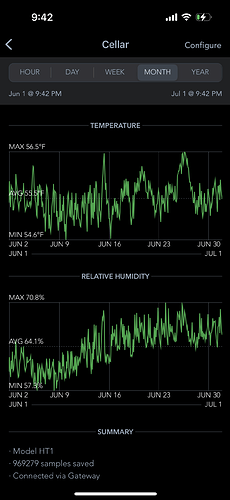Depends on your AC.
If you use the ducts for your home, you will never get cool enough because nobody wants to hang out at that temp. If you have a dedicated unit however, you can drop the temp.
In your case, what I would do is put a bottle of water on the floor and take that temp. Your floor may not be the temp of the space just above and you want to know how cool your wine will be, not the floor. If you can just block off some area with some kind of barrier and put a little box or shelf in there, put another bottle higher up off the floor and take that temp too.
Sounds like you’re hoping that the floor will cool the room, or take in enough heat, to suffice for the entire room. It may but it won’t keep your wine at 56F. If you can keep it in the 60s through the summer, you will be OK. There are many many passive cellars in Europe that have that kind of temp. When they dig into the mountain, like they do all over Hungary, you get much cooler, damper places and mold grows on your bottles, so they wrap them in plastic. But you won’t get that cold or wet in your basement.
The second bit you can think about is that even a large cellar will probably be adequately cooled by a very small window AC that you can get for $90 at Lowes or Home Depot. Some of those will actually go down to 61F or so, and if you build that into a wall, you can use it in July and August and rely on the passive cooling the rest of the time. And it can serve as your fan as well. The unit will be oversized for your cellar, which means it will cycle off quickly and won’t drop the humidity like it’s supposed to for your bedroom, and that is exactly what you want for your cellar.
There are ways to trick the AC unit to get colder, but it’s not necessary. Just get one that goes way down and keep it at the lowest setting. I kept wine for over 10 years with that little setup and the wine is still fine. We had a 1992 Dunn the other day and it was stellar. I just vented it into the rest of the basement. It was never a problem because as I said, it’s not running most of the time.
People worry WAY too much about humidity. That is the least important issue for you - the wine in the bottles will ensure that the headspace humidity is adequate. And wine does not escape through the cork if you don’t put the bottles on their sides. You put them on their sides because it’s more efficient to store them that way.
Vapor barriers have their own mythology around here.
What causes vapor?
You get vapor when you have something cold enough to reach the dew point of the other side of the container. You take a Coke from the fridge and set it on the counter and you get condensation. In a passive cellar, how would you get such a gradient? Even if you insulate the cellar the rest of the space is still that same basement. If you built the cellar in the attic where the temp is 110F and you cooled the cellar to 50F, you would want a lot of insulation and probably a vapor barrier. But if you’re talking 60F inside and 65F outside, you won’t get vapor, especially if you insulate reasonably well. I used no vapor barrier at all. But just in case, I used Wonderboard, not drywall. Drywall is never vapor proof - the green stuff is the same as the other stuff. And while Wonderboard doesn’t look all that great with the bubble holes. it’s not going to be visible since you’ll have wine in the cellar. So who cares? In fact, the cellar is just a closet, so who cares what it looks like inside? I never understood tricking them out with special lighting and expensive racks, but to each his own.
BTW - the wine cellar units are NOT specialized units. All refrigerators, air conditioners, and wine cellars work on the exact same principle - condense a gas into a liquid, move it into another location and let it suddenly turn back into a gas, and then repeat. You add heat on one side and absorb heat on the other side. For super-suckers however, they do produce wine fridges with dual zones, one for whites and one for reds. I can’t believe anyone would ever buy one, but when it comes to wine, myth trumps reality. Kind of like many things in life.
Good luck.
